
January 2017
Cops, Feds, Pipeline Companies – Get Out of Indian Lands!
The Battle Over Standing Rock
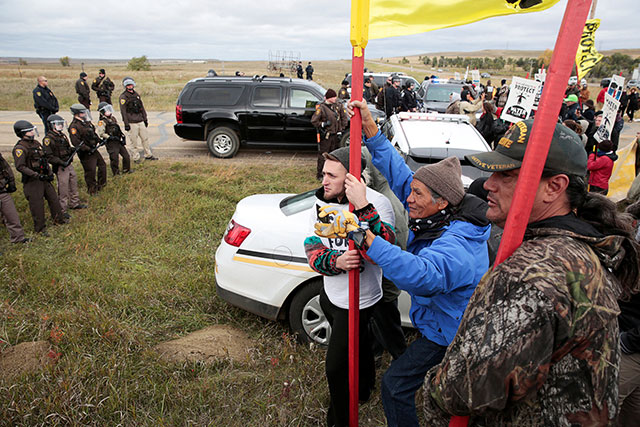
Protesters face off with police near site where pipeline is slated to cross the Missouri River next to the Standing Rock Indian Reservation. (Terray Sylvester/Reuters)
The struggle over the Dakota Access Pipeline (DAPL) in North Dakota is not just against a profit-greedy consortium of oil companies. It poses a battle against a ruling class which established its sway through enslavement of African Americans and genocide against the Native American peoples, and has persecuted them ever since. The 1,172-mile pipeline would cross the Missouri River just north of the current boundaries of the Standing Rock Indian Reservation, potentially polluting the water supply to the population in case of a spill. With county sheriffs and state police acting as guard dogs for the oil companies, the standoff quickly became a conflict over Indian rights facing powerful corporations and the racist repressive forces of the capitalist state that does their bidding. In this battle, class-conscious workers and revolutionaries must stand squarely on the side of the Standing Rock Sioux.
Now, with winter storms and the election of DAPL investor Donald Trump as U.S. president, the battle continues. The announcement by the U.S. Department of the Army on December 4 that it would not grant the pipeline builders a necessary easement (permit) to drill under Lake Oahe, a dammed section of the Missouri River, was met with elation in the three camps of several thousand Native American and other protesters who had gathered near the site at the mouth of the Cannonball River. People shouted “Mni wiconi” – water is life – the watchword of the protest. Standing Rock Sioux tribal authorities declared that they and “all of Indian Country will be forever grateful to the Obama Administration for this historic decision.” They also urged protesters to return home as soon as possible. Other tribe members objected that they did not trust the government and would not leave until the pipeline was definitively stopped.
Liberals were jubilant. “This Is What Victory Over The Dakota Access Pipeline At Standing Rock Looks Like” gushed the Huffington Post (4 December). A “historic victory,” proclaimed The Atlantic (5 December). The action by Obama-appointed top brass at the Pentagon – which commands the Army Corps of Engineers, with jurisdiction over the Lake Oahe federal flood control project – put a crimp in the drive to complete the DAPL at breakneck speed by January 1. But the effect will likely be temporary (see “Hands Off Standing Rock Sioux!”The Internationalist, 4 December). Trump’s support for the pipeline was quickly reaffirmed by his transition team. The incoming chief executive officer of American capitalism has vowed to “unleash” unfettered production of oil and gas and has holdings of stock in ETP, the main owner of the pipeline, and in Phillips 66, which holds a quarter of the DAPL stock.
 Kelcy
Warren, CEO of Energy Transfer Partners and Sunoco Logistics,
the two main owners of the Dakota Access Pipeline.
Kelcy
Warren, CEO of Energy Transfer Partners and Sunoco Logistics,
the two main owners of the Dakota Access Pipeline. (John L. Mone/AP)
Moreover, Kelcy Warren, the CEO of ETP, was a major donor to Trump and gave $3 million to the Republican campaign. North Dakota governor Jack Dalrymple, who threatened mass arrests of pipeline protesters, was a Trump campaign energy advisor. Trump’s nominee for energy secretary is former Texas governor Rick Perry, a wholly owned asset of Warren. Perry sits on the board of directors of ETP and on the board of Sunoco Logistics Partners, the two main owners of the DAPL, both controlled by Warren, who also bankrolled Perry’s failed presidential bid.1 Rex Tillerson, CEO of ExxonMobil, will be secretary of state; Scott Pruitt, a creature of Oklahoma’s Devon Energy and Continental Resources, the biggest producer in North Dakota’s Bakken oil patch, will run the Environmental Protection Agency;2 and former Alabama senator Jeff Sessions, a hard-line pro-cop racist, will be attorney general. An administration of Big Oil and unbridled police power ensures that the battle over Standing Rock will reignite after January 20.
It was the vicious repression of protesters that made Standing Rock national news in the first place. A boiling point came in late August when Republican governor Dalrymple declared a state of emergency. On September 3, security guards hired by ETP brutally attacked Indian and other demonstrators at a construction site near the Sacred Stone Camp near Cannon Ball. Vicious dogs were set on the protestors and pepper spray used against demonstrators, including children. TV footage on Democracy Now viewed by more than 13 million people recalled scenes of 1963 police attacks on civil rights marchers in Birmingham, Alabama. The response of the state of North Dakota was to issue a warrant for the arrest of Democracy Now producer Amy Goodman in a blatant attempt to intimidate media coverage. At least seven journalists have been arrested during the protests, deliberately targeted by the county sheriff.
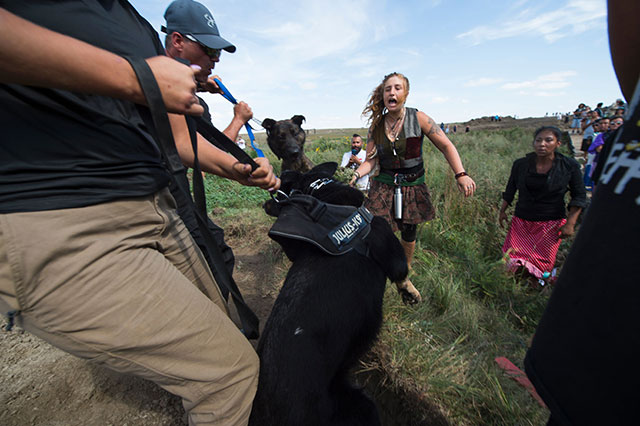
Unlicensed security guards hired by ETP used dogs to attack protesters, including women and children.
(Getty Images)
In response to widespread outrage over the repression, the Obama administration revoked authorization for pipeline construction on federal land on September 9, and asked ETP to temporarily stop building where demonstrations are ongoing. The company refused. A week later, a federal court ordered a brief halt on construction. But on October 9 a federal appeals court denied the request for an injunction. Two weeks later a militarized force of state and local police beefed up with riot cops from Wisconsin, Indiana, South Dakota, Minnesota, Wyoming and Nebraska launched an assault on the 1851 Treaty Camp, trying to drive out protesters. Using pepper spray, tear gas, rubber bullets, LRAD sound cannons producing ear-splitting noise, helicopters overhead and armored Humvees and Bearcat personnel carriers, provided courtesy of the Pentagon, the “forces of order” arrested more than 140 people.
The multi-state police force was assembled under the Emergency Management Assistance Compact (EMAC), which was signed into law by Democratic president Bill Clinton in 1996. Supposedly intended to enable states to cooperate in the face of national disasters, it also authorizes a cobbled-together paramilitary police force in the face of “community disorders, insurgency, or enemy attack.” EMAC has been used only twice against protests: first in Baltimore, Maryland following the police murder of Freddie Gray, and now in Standing Rock. While this was largely ignored by “mainstream” bourgeois print and broadcast media, it provoked protests in Minneapolis, Cincinnati and Madison, Wisconsin demanding recall of police. But North Dakota authorities and police forces around the Midwest see Standing Rock as Baltimore West or Ferguson North, a “civil disturbance” to be suppressed at all costs.
The scene was surreal: hundreds of police strung out in a line in the prairie, writing numbers on the arms of arrested protesters and holding them in pens resembling dog kennels; sophisticated police communications vehicles trucked in from hundreds of miles away, and sound cannons blasting away in the middle of vast open spaces. The sheriff of Cass County (Fargo), with no jurisdiction in the area, accused demonstrators of using “very dangerous means” … like horses.
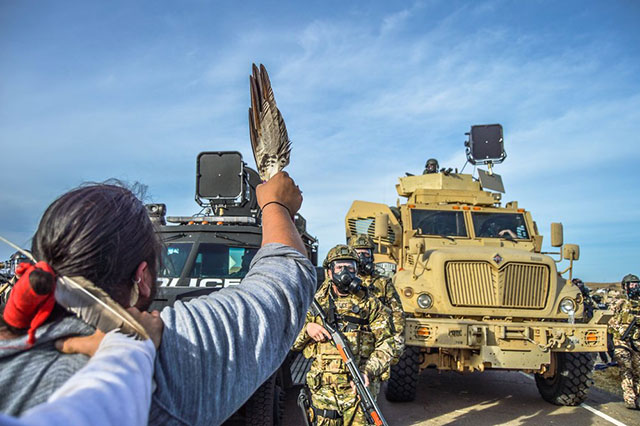
Multi-state police force used LRAD sound cannon mounted atop armored personnel carriers to blast demonstrators with ear-splitting noise. (Rob Wilson Photography)
Then at the beginning of Thanksgiving week, cops launched an even more vicious attack on the water protectors at Standing Rock. Police water cannon drenched protesters in sub-freezing (23º Fahrenheit) weather, injuring 300. They justified this potentially lethal tactic by claiming the praying Indians were engaged in an “on-going riot.” Protesters were severely injured, including a women who lost the use of her arm after it was nearly blown off, and another who is now blind in one eye after being hit in the face by a tear gas canister.
Standing Rock Sioux tribal chairman David Archambault II appealed for federal intervention against the “militarized law enforcement.” So the Army Corps of Engineers regional commander in Omaha (who in July approved DAPL plans to tunnel under Lake Oahe, and was being sued by the tribe) decreed the Oceti Sakowin (Seven Council Fires) camp must shut down by December 5 in order to “protect the general public from the violent confrontations” with police, with protest confined to a “free speech” pen. Corps commander John Henderson said he acted from “concern for public safety and the fact that much of this land is leased to private persons for grazing and/or haying purposes.” Governor Dalrymple ordered the area cleared because it is “not zoned for dwellings suitable for living in winter conditions.” The Morton County sheriff (who ordered the water cannon attack) said protesters must not subject themselves to “life-threatening conditions.”
The stage was set for a showdown. Several thousand Native American and other veterans mobilized to converge on Standing Rock to protect the water protectors. The potential clash between two trained military forces was defused by the decision by the Department of the Army – not by the Corps of Engineers, as was widely and erroneously reported in the press. The Corps was ordered to engage in “a robust consideration of alternative locations for the pipeline crossing the Missouri River,” including the alternative crossing north of Bismarck, and “detailed discussion of potential risk of an oil spill” at the lake. But the Corps is viscerally hostile to the Indian population (whose lands they submerged in damming the river and creating Lake Oahe in 1958), and the political echelon of the Pentagon will soon be replaced by a Trump administration that is beholden to the oil companies and an eager proponent of police power.
The brutal repression dealt out to protesters at Standing Rock, North Dakota in 2016 – using paramilitary forces just as were used against black demonstrators in Ferguson, Missouri in 2014 and Baltimore, Maryland in 2015 – is directly related to the fact that the protests have been led by, and the bulk of the protesters are, Indians. The placement of the pipeline and the ferocity of its paramilitary guards against peaceful protesters is, as Standing Rock chairman Archambault put it, “not at all surprising given the last 500 years of the mistreatment of our people.” While African Americans, brought here in chains, have had to endure four centuries of oppression, from chattel slavery to Jim Crow segregation and now mass incarceration and wanton police murder, Native Americans subjected to genocide are still under siege over five centuries later.
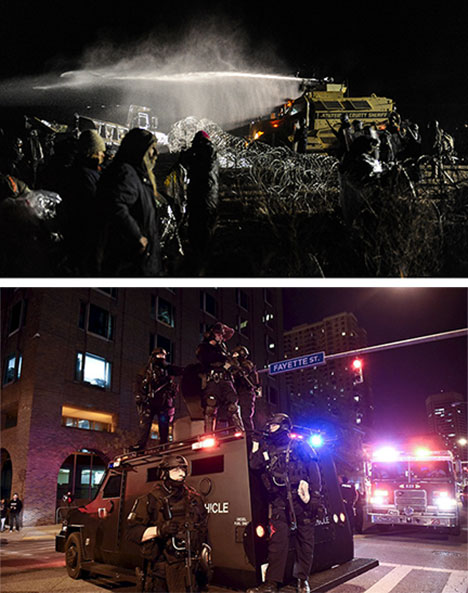 Paramilitary police action against
Native American protesters at Standing Rock, North Dakota
(November 2016) and to suppress African American upheaval in
Baltimore, Maryland (May 2015).
Paramilitary police action against
Native American protesters at Standing Rock, North Dakota
(November 2016) and to suppress African American upheaval in
Baltimore, Maryland (May 2015). (Photos: Stephanie Keith/Reuters; Reuters)
You couldn’t miss the contrast between the October 28 acquittal of the Bundy brothers, the white ranchers who led an armed takeover of the Malheur federal wildlife refuge in Oregon (a former reservation stolen from the Paiute people after they rose up in 1878) and the relentless persecution of unarmed Indians in North Dakota protesting a pipeline being built on reservation land stolen from the Dakota Sioux as part of an 1868 land grab (“Fake Cowboys and Real Indians,” New York Times, 2 December). Anti-Indian racism is endemic among North Dakota’s rulers. Last year the Republican-controlled legislature passed a voter registration law that would disenfranchise thousands of Native Americans who don’t have a street address – a deliberate attack on the reservation population, whose ID cards lack street addresses since most receive mail at post office boxes. A federal judge threw out the racist law.
The whole battle over the Dakota Access Pipeline at Standing Rock is a blatant case of environmental racism. The original route plotted in May 2014 would have crossed the Missouri ten miles north of the state capital, Bismarck. However, this was rejected by the Corps of Engineers because of “public input” (i.e., politicians’ objections), more “desktop evaluation” and proximity to populated “high consequence areas.”3 Danger to an Indian reservation and its water intake in case of a leak was not deemed “high consequence.” In fact, objections from Standing Rock about a river crossing a half mile north of the reservation were not even mentioned in the 983 pages of the November 2015 Army Corps Draft Environmental Assessment (written entirely by Dakota Access). So to shorten the route and avoid the need for new easements, the pipeline was routed in the same corridor as the existing Northern Border natural gas pipeline.
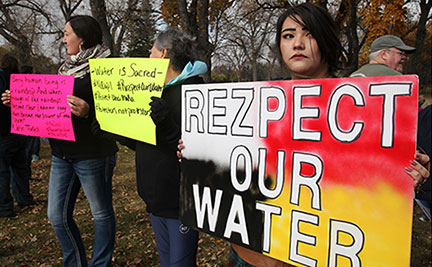 Protest by Standing Rock Youth at
state capitol in Bismarck, North Dakota, 29 October 2016.
Protest by Standing Rock Youth at
state capitol in Bismarck, North Dakota, 29 October 2016. (John L. Mone/AP)
The parallel is inescapable to the now infamous Flint water crisis, where the largely black and working-class Michigan industrial city had its water supply poisoned by state officials’ decisions to switch the supply source as a budget-cutting measure (see “Flint Water Crisis: Capitalism Is Poisoning Us,” Revolution No. 13, March 2016). As the December 5 showdown in Standing Rock loomed, a carload of veterans made the 17-hour drive from Flint to show their solidarity. “We know in Flint that water is in dire need,” said one. “In North Dakota, they’re trying to force pipes on people. We’re trying to get pipes in Flint for safe water” (Associated Press, 4 December). Serious ecological and environmental issues under capitalism have an often dominant content of class and racial oppression. So to fight off the attacks by a rapacious ruling class, you need a revolutionary program of class struggle.
While the protests at Standing Rock have emphasized the tribe’s opposition to routing the Dakota Access Pipeline through Sioux lands, elsewhere (and particularly on the East Coast) demonstrations against DAPL have focused on ecological issues and opposition to the pipeline as such and oil production overall. Some signs say, “Keep It In the Ground.” We are not for or against the pipeline, but we support the right of the Dakota Sioux to keep it out. If they objected to a project to grow petunias (or more likely, sunflowers), we would also support the right of a dispossessed Native American people to defend their lands. The call for an immediate end to the production of oil, on the other hand, is a petty-bourgeois anti-working class demand that would shut down industry. Those who raise it should hand over their iPhones, iPads, MacBook Air laptops, air conditioners, and their electric-powered Toyota Priuses (or gas-guzzling SUVs).
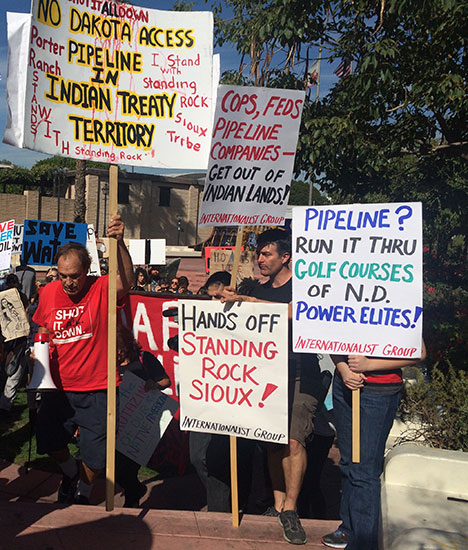 Internationalist Group at November
3 Los Angeles demonstration protests attempt to run pipeline
through Standing Rock Sioux lands, potentially endangering
water supply and violating Native American rights.
Internationalist Group at November
3 Los Angeles demonstration protests attempt to run pipeline
through Standing Rock Sioux lands, potentially endangering
water supply and violating Native American rights. (Internationalist photo)
In focusing on pipelines, eco-radicals and Democratic Party liberals are in effect promoting a potentially far more dangerous method of transporting petroleum products: the oil trains that today carry the majority of the Bakken oilfields production. Pipelines are safer, but where they go and what safety measures are required is a class question. An Internationalist Group sign at a November 3 Standing Rock protest in Los Angeles read: “Pipeline? Run It Thru Golf Courses of N.D. Power Elites!” As a modest proposal, since the governor is so hot for DAPL, we suggest running the pipes smack through the middle of the Apple Creek Country Club (“the only private club in the Bismarck-Mandan area”) where the Friends of Jack Dalrymple hold the governor’s cup golf tournament. Meanwhile, we say: “Cops, Feds, Pipeline Companies – Get Out of Indian Lands!” (see “Hands Off Standing Rock Sioux,” The Internationalist, 4 December 2016). ■
- 1. See “In Money Race, Rick Perry's Campaign Shows the Power of Few,” Bloomberg, 31 July 2015. The article quotes Donald Trump saying, “When you have people giving you millions of dollars, when they call up, even if it’s not the best interest of the United States, you do what they tell you to do. Who knows it better than me? I give to everybody, they do whatever I say.”
- 2. See “Energy and Regulators on One Team,” New York Times, 7 December 2014.
- 3. See “Pipeline route Plan First Called for Crossing North of Bismarck,” Bismarck Tribune, 18 August; and “Why a Previously Proposed Route for the Dakota Access Pipeline Was Rejected,” ABC News, 3 November.
- See also: Standing
Rock and the Revolutionary Fight for Native
American Rights (7 January
2017)
Pipelines, Oil Trains and Capitalism (7 January 2017)
Spartacist League: Land Surveyor Socialists (7 January 2017)
